What is SCADA?
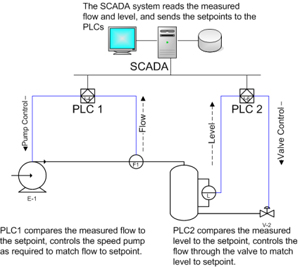 The
SCADA acronym stands for Supervisory Control and Data Acquisition.
SCADA systems are commonly used for utility companies such as electric,
water, and gas. The general idea for these systems is to be able to
monitor and control some level or status using programmable logic
controllers (PLCs) or remote terminal units (RTUs) and report it back
to a main server or master station. The master station can be
programmed to use this information to control other operations or just
to monitor the data. The data is distriubuted over a network to Human
Machine Interfaces (HMIs). The
SCADA acronym stands for Supervisory Control and Data Acquisition.
SCADA systems are commonly used for utility companies such as electric,
water, and gas. The general idea for these systems is to be able to
monitor and control some level or status using programmable logic
controllers (PLCs) or remote terminal units (RTUs) and report it back
to a main server or master station. The master station can be
programmed to use this information to control other operations or just
to monitor the data. The data is distriubuted over a network to Human
Machine Interfaces (HMIs).
HMI
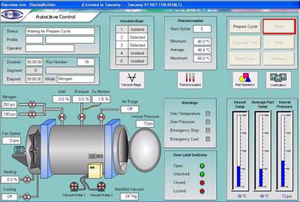 The
HMI is merely a computer with special software allowing a graphical
user interface into the SCADA system. The screen shot (Left) is one
example of an HMI software package. There are several guages and input
fields on the screen. The input fields could be used to send commands
to the remote units to control flow of air, water, or some chemical. The
HMI is merely a computer with special software allowing a graphical
user interface into the SCADA system. The screen shot (Left) is one
example of an HMI software package. There are several guages and input
fields on the screen. The input fields could be used to send commands
to the remote units to control flow of air, water, or some chemical.
HMI
software packages vary widely in looks and functionality. The system
that the City uses is vastly different than that shown in the example.
The City actually uses two different types of display screens. One is
called a single line diagram or SLD and the other is the updated
WorldView package offered by the SCADA vendor, QEI.
PLC
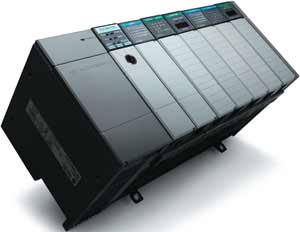 The
remote terminal unit (RTU) or programmable logic controller (PLC) is
the device out in the field that is collecting data and controlling
other devices such as valves or breakers. In general, the City uses
RTUs out in the field rather than PLCs (Left). There are significant
differences between the two although many manufacturers are building
them to be very similar. The typical RTU was designed to have inputs
for status such as door, valve, and breaker positions (digital data) as
well as flow rates or electrical current output (analog data). It will
also have some control functions to be able to open and close breakers
and valves and such. The
remote terminal unit (RTU) or programmable logic controller (PLC) is
the device out in the field that is collecting data and controlling
other devices such as valves or breakers. In general, the City uses
RTUs out in the field rather than PLCs (Left). There are significant
differences between the two although many manufacturers are building
them to be very similar. The typical RTU was designed to have inputs
for status such as door, valve, and breaker positions (digital data) as
well as flow rates or electrical current output (analog data). It will
also have some control functions to be able to open and close breakers
and valves and such.
PLC Programming
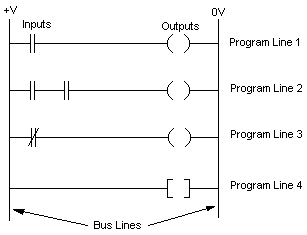 The
PLC has all those abilities with some small differences, but one major
difference is that PLCs are programmable. The program is usually a
ladder logic program which can take the analog and digital inputs and
make decisisions. This decision making process can control a water
treatment process called chemical pacing or it can operate a standby
generator. Within the last 8 or so years, SCADA manufacturers have
started to incorporate some of this functionality into the RTUs.
Previously that functionality was accomplished at the master station
level on a limited basis. The
PLC has all those abilities with some small differences, but one major
difference is that PLCs are programmable. The program is usually a
ladder logic program which can take the analog and digital inputs and
make decisisions. This decision making process can control a water
treatment process called chemical pacing or it can operate a standby
generator. Within the last 8 or so years, SCADA manufacturers have
started to incorporate some of this functionality into the RTUs.
Previously that functionality was accomplished at the master station
level on a limited basis.
RTU
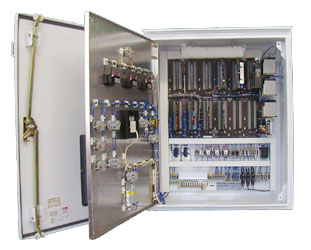 The
RTU can look much more different than a PLC or some PLC manufacturers
call their PLCs an RTU. This is where the water starts to get a little
muddy. In the past and still today they usually are larger and a lot of
times they are much larger and mounted in large racks or cabinets. Many
people would question why an RTU would be used over a PLC, but
generally the true RTU analog, digital, and control inputs and outputs
are a more hardened type of connection and less susceptible to
electrical interference and surges. In addition, because the RTU
usually does not have programming involved, the RTU is cheaper to
purchase and easier to get up and running and maintain. The
RTU can look much more different than a PLC or some PLC manufacturers
call their PLCs an RTU. This is where the water starts to get a little
muddy. In the past and still today they usually are larger and a lot of
times they are much larger and mounted in large racks or cabinets. Many
people would question why an RTU would be used over a PLC, but
generally the true RTU analog, digital, and control inputs and outputs
are a more hardened type of connection and less susceptible to
electrical interference and surges. In addition, because the RTU
usually does not have programming involved, the RTU is cheaper to
purchase and easier to get up and running and maintain.
How do you know when to choose an RTU or PLC?
That truly depends on the application. The more automation you desire,
the more likely you are to choose a PLC. The PLC performs local
automation through its internal programming so if communications to the
server(s) is lost, the program may still operate. Although RTUs have
come a long way, they are generally not involved in a great deal of
local automation. The City of Manassas has a few PLCs scattered
throughout the Water Plant, but the majority of the site equipment are
RTUs therefore this site is dedicated mostly to development and
training on RTUs. |


 The
SCADA acronym stands for Supervisory Control and Data Acquisition.
SCADA systems are commonly used for utility companies such as electric,
water, and gas. The general idea for these systems is to be able to
monitor and control some level or status using programmable logic
controllers (PLCs) or remote terminal units (RTUs) and report it back
to a main server or master station. The master station can be
programmed to use this information to control other operations or just
to monitor the data. The data is distriubuted over a network to Human
Machine Interfaces (HMIs).
The
SCADA acronym stands for Supervisory Control and Data Acquisition.
SCADA systems are commonly used for utility companies such as electric,
water, and gas. The general idea for these systems is to be able to
monitor and control some level or status using programmable logic
controllers (PLCs) or remote terminal units (RTUs) and report it back
to a main server or master station. The master station can be
programmed to use this information to control other operations or just
to monitor the data. The data is distriubuted over a network to Human
Machine Interfaces (HMIs). The
HMI is merely a computer with special software allowing a graphical
user interface into the SCADA system. The screen shot (Left) is one
example of an HMI software package. There are several guages and input
fields on the screen. The input fields could be used to send commands
to the remote units to control flow of air, water, or some chemical.
The
HMI is merely a computer with special software allowing a graphical
user interface into the SCADA system. The screen shot (Left) is one
example of an HMI software package. There are several guages and input
fields on the screen. The input fields could be used to send commands
to the remote units to control flow of air, water, or some chemical. The
remote terminal unit (RTU) or programmable logic controller (PLC) is
the device out in the field that is collecting data and controlling
other devices such as valves or breakers. In general, the City uses
RTUs out in the field rather than PLCs (Left). There are significant
differences between the two although many manufacturers are building
them to be very similar. The typical RTU was designed to have inputs
for status such as door, valve, and breaker positions (digital data) as
well as flow rates or electrical current output (analog data). It will
also have some control functions to be able to open and close breakers
and valves and such.
The
remote terminal unit (RTU) or programmable logic controller (PLC) is
the device out in the field that is collecting data and controlling
other devices such as valves or breakers. In general, the City uses
RTUs out in the field rather than PLCs (Left). There are significant
differences between the two although many manufacturers are building
them to be very similar. The typical RTU was designed to have inputs
for status such as door, valve, and breaker positions (digital data) as
well as flow rates or electrical current output (analog data). It will
also have some control functions to be able to open and close breakers
and valves and such. The
PLC has all those abilities with some small differences, but one major
difference is that PLCs are programmable. The program is usually a
ladder logic program which can take the analog and digital inputs and
make decisisions. This decision making process can control a water
treatment process called chemical pacing or it can operate a standby
generator. Within the last 8 or so years, SCADA manufacturers have
started to incorporate some of this functionality into the RTUs.
Previously that functionality was accomplished at the master station
level on a limited basis.
The
PLC has all those abilities with some small differences, but one major
difference is that PLCs are programmable. The program is usually a
ladder logic program which can take the analog and digital inputs and
make decisisions. This decision making process can control a water
treatment process called chemical pacing or it can operate a standby
generator. Within the last 8 or so years, SCADA manufacturers have
started to incorporate some of this functionality into the RTUs.
Previously that functionality was accomplished at the master station
level on a limited basis. The
RTU can look much more different than a PLC or some PLC manufacturers
call their PLCs an RTU. This is where the water starts to get a little
muddy. In the past and still today they usually are larger and a lot of
times they are much larger and mounted in large racks or cabinets. Many
people would question why an RTU would be used over a PLC, but
generally the true RTU analog, digital, and control inputs and outputs
are a more hardened type of connection and less susceptible to
electrical interference and surges. In addition, because the RTU
usually does not have programming involved, the RTU is cheaper to
purchase and easier to get up and running and maintain.
The
RTU can look much more different than a PLC or some PLC manufacturers
call their PLCs an RTU. This is where the water starts to get a little
muddy. In the past and still today they usually are larger and a lot of
times they are much larger and mounted in large racks or cabinets. Many
people would question why an RTU would be used over a PLC, but
generally the true RTU analog, digital, and control inputs and outputs
are a more hardened type of connection and less susceptible to
electrical interference and surges. In addition, because the RTU
usually does not have programming involved, the RTU is cheaper to
purchase and easier to get up and running and maintain.